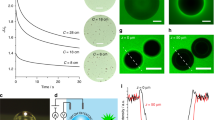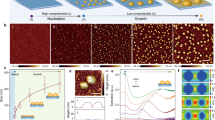Abstract
Understanding and manipulating gas bubble evolution during electrochemical water splitting is a crucial strategy for optimizing the electrode/electrolyte/gas bubble interface. Here gas bubble dynamics are investigated during the hydrogen evolution reaction on a well-defined platinum microelectrode by varying the electrolyte composition. We find that the microbubble coalescence efficiency follows the Hofmeister series of anions in the electrolyte. This dependency yields very different types of H2 gas bubble evolution in different electrolytes, ranging from periodic detachment of a single H2 gas bubble in sulfuric acid to aperiodic detachment of small H2 gas bubbles in perchloric acid. Our results indicate that the solutal Marangoni convection, induced by the anion concentration gradient developing during the reaction, plays a critical role at practical current density conditions. The resulting Marangoni force on the H2 gas bubble and the bubble departure diameter therefore depend on how surface tension varies with concentration for different electrolytes. This insight provides new avenues for controlling bubble dynamics during electrochemical gas bubble formation.

This is a preview of subscription content, access via your institution
Access options
Access Nature and 54 other Nature Portfolio journals
Get Nature+, our best-value online-access subscription
$29.99 / 30 days
cancel any time
Subscribe to this journal
Receive 12 print issues and online access
$259.00 per year
only $21.58 per issue
Buy this article
- Purchase on Springer Link
- Instant access to full article PDF
Prices may be subject to local taxes which are calculated during checkout






Similar content being viewed by others
Data availability
All relevant data generated and analysed during this study are included in this article and its Supplementary Information. Data for the main figures are available in Zenodo (https://doi.org/10.5281/zenodo.7867261).
References
Turner, J. A. Sustainable hydrogen production. Science 305, 972–974 (2004).
Ardo, S. et al. Pathways to electrochemical solar-hydrogen technologies. Energy Environ. Sci. 11, 2768–2783 (2018).
Buttler, A. & Spliethoff, H. Current status of water electrolysis for energy storage, grid balancing and sector coupling via power-to-gas and power-to-liquids: a review. Renew. Sustain. Energy Rev. 82, 2440–2454 (2018).
Shih, A. J. et al. Water electrolysis. Nat. Rev. Methods Primers 2, 84 (2022).
Chatenet, M. et al. Water electrolysis: from textbook knowledge to the latest scientific strategies and industrial developments. Chem. Soc. Rev. 51, 4583–4762 (2022).
Seh, Z. W. et al. Combining theory and experiment in electrocatalysis: insights into materials design. Science 355, eaad4998 (2017).
Dubouis, N. & Grimaud, A. The hydrogen evolution reaction: from material to interfacial descriptors. Chem. Sci. 10, 9165–9181 (2019).
Ledezma-Yanez, I. et al. Interfacial water reorganization as a pH-dependent descriptor of the hydrogen evolution rate on platinum electrodes. Nat. Energy 2, 1–7 (2017).
Li, P. et al. Hydrogen bond network connectivity in the electric double layer dominates the kinetic pH effect in hydrogen electrocatalysis on Pt. Nat. Catal. 5, 900–911 (2022).
Diaz-Morales, O., Ferrus-Suspedra, D. & Koper, M. T. M. The importance of nickel oxyhydroxide deprotonation on its activity towards electrochemical water oxidation. Chem. Sci. 7, 2639–2645 (2016).
Kamat, G. A. et al. Acid anion electrolyte effects on platinum for oxygen and hydrogen electrocatalysis. Commun. Chem. 5, 20 (2022).
Garcia, A. C., Touzalin, T., Nieuwland, C., Perini, N. & Koper, M. T. M. Enhancement of oxygen evolution activity of nickel oxyhydroxide by electrolyte alkali cations. Angew. Chem. Int. Ed. 58, 12999–13003 (2019).
Dukovic, J. & Tobias, C. W. The influence of attached bubbles on potential drop and current distribution at gas-evolving electrodes. J. Electrochem. Soc. 134, 331–343 (1987).
Gabrielli, C., Huet, F. & Nogueira, R. P. Fluctuations of concentration overpotential generated at gas-evolving electrodes. Electrochim. Acta 50, 3726–3736 (2005).
Vogt, H. & Balzer, R. J. The bubble coverage of gas-evolving electrodes in stagnant electrolytes. Electrochim. Acta 50, 2073–2079 (2005).
Vogt, H. The voidage problem in gas-electrolyte dispersions. J. Appl. Electrochem. 17, 419–426 (1987).
Fouad, M. G. & Sedahmed, G. H. Mass transfer at horizontal gas-evolving electrodes. Electrochim. Acta 18, 55–58 (1973).
Xu, W., Lu, Z., Sun, X., Jiang, L. & Duan, X. Superwetting electrodes for gas-involving electrocatalysis. Acc. Chem. Res. 51, 1590–1598 (2018).
Angulo, A., van der Linde, P., Gardeniers, H., Modestino, M. & Fernández Rivas, D. Influence of bubbles on the energy conversion efficiency of electrochemical reactors. Joule 4, 555–579 (2020).
Zhao, X., Ren, H. & Luo, L. Gas bubbles in electrochemical gas evolution reactions. Langmuir 35, 5392–5408 (2019).
Yang, S. et al. Electrolytically generated nanobubbles on highly orientated pyrolytic graphite surfaces. Langmuir 25, 1466–1474 (2009).
van der Linde, P. et al. Electrolysis-driven and pressure-controlled diffusive growth of successive bubbles on microstructured surfaces. Langmuir 33, 12873–12886 (2017).
Luo, L. & White, H. S. Electrogeneration of single nanobubbles at sub-50-nm-radius platinum nanodisk electrodes. Langmuir 29, 11169–11175 (2013).
Soto, A. M. et al. The nucleation rate of single O2 nanobubbles at Pt nanoelectrodes. Langmuir 34, 7309–7318 (2018).
German, S. R., Edwards, M. A., Ren, H. & White, H. S. Critical nuclei size, rate, and activation energy of H2 gas nucleation. J. Am. Chem. Soc. 140, 4047–4053 (2018).
Yang, X., Baczyzmalski, D., Cierpka, C., Mutschke, G. & Eckert, K. Marangoni convection at electrogenerated hydrogen bubbles. Phys. Chem. Chem. Phys. 20, 11542–11548 (2018).
Massing, J. et al. Thermocapillary convection during hydrogen evolution at microelectrodes. Electrochim. Acta 297, 929–940 (2019).
Bashkatov, A., Hossain, S. S., Yang, X., Mutschke, G. & Eckert, K. Oscillating hydrogen bubbles at Pt microelectrodes. Phys. Rev. Lett. 123, 214503 (2019).
Lohse, D. & Zhang, X. Surface nanobubbles and nanodroplets. Rev. Mod. Phys. 87, 981 (2015).
Scriven, L. E. & Sternling, C. V. The Marangoni effects. Nature 187, 186–188 (1960).
Lohse, D. & Zhang, X. Physicochemical hydrodynamics of droplets out of equilibrium. Nat. Rev. Phys. 2, 426–443 (2020).
Lamy-Pitara, E., El Mouahid, S. & Barbier, J. Effect of anions on catalytic and electrocatalytic hydrogenations and on the electrocatalytic oxidation and evolution of hydrogen on platinum. Electrochim. Acta 45, 4299–4308 (2000).
de Groot, M. T. & Koper, M. T. M. The influence of nitrate concentration and acidity on the electrocatalytic reduction of nitrate on platinum. J. Electroanal. Chem. 562, 81–94 (2004).
Fernandez, D., Maurer, P., Martine, M., Coey, J. M. D. & Möbius, M. E. Bubble formation at a gas-evolving microelectrode. Langmuir 30, 13065–13074 (2014).
Zhang, Y. & Cremer, P. S. Interactions between macromolecules and ions: the Hofmeister series. Curr. Opin. Chem. Biol. 10, 658–663 (2006).
Pegram, L. M. & Record, M. T. Hofmeister salt effects on surface tension arise from partitioning of anions and cations between bulk water and the air–water interface. J. Phys. Chem. B 111, 5411–5417 (2007).
Prince, M. J. & Blanch, H. W. Bubble coalescence and break‐up in air‐sparged bubble columns. AlChE J. 36, 1485–1499 (1990).
Liao, Y. & Lucas, D. A literature review on mechanisms and models for the coalescence process of fluid particles. Chem. Eng. Sci. 65, 2851–2864 (2010).
Craig, V. S. & Henry, C. L. Specific Ion Effects (World Scientific, 2010).
Craig, V. S. J., Ninham, B. W. & Pashley, R. M. The effect of electrolytes on bubble coalescence in water. J. Phys. Chem. 97, 10192–10197 (1993).
Monzon, L. M. A., Gillen, A. J., Mobius, M. E. & Coey, J. M. D. Effect of tetraalkylammonium cations on gas coalescence at a hydrogen-evolving microelectrode. Langmuir 31, 5738–5747 (2015).
Weissenborn, P. K. & Pugh, R. J. Surface tension of aqueous solutions of electrolytes: relationship with ion hydration, oxygen solubility, and bubble coalescence. J. Colloid Interface Sci. 184, 550–563 (1996).
Firouzi, M., Howes, T. & Nguyen, A. V. A quantitative review of the transition salt concentration for inhibiting bubble coalescence. Adv. Colloid Interface Sci. 222, 305–318 (2015).
Chen, Q., Luo, L., Faraji, H., Feldberg, S. W. & White, H. S. Electrochemical measurements of single H2 nanobubble nucleation and stability at Pt nanoelectrodes. J. Phys. Chem. Lett. 5, 3539–3544 (2014).
Newton, M. R. et al. Anisotropic diffusion in face-centered cubic opals. Nano Lett. 4, 875–880 (2004).
Brandon, N. P. & Kelsall, G. H. Growth kinetics of bubbles electrogenerated at microelectrodes. J. Appl. Electrochem. 15, 475–484 (1985).
Wang, Y. et al. Vapor and gas-bubble growth dynamics around laser-irradiated, water-immersed plasmonic nanoparticles. ACS Nano 11, 2045–2051 (2017).
Yang, X., Karnbach, F., Uhlemann, M., Odenbach, S. & Eckert, K. Dynamics of single hydrogen bubbles at a platinum microelectrode. Langmuir 31, 8184–8193 (2015).
Hossain, S. S., Bashkatov, A., Yang, X., Mutschke, G. & Eckert, K. Force balance of hydrogen bubbles growing and oscillating on a microelectrode. Phys. Rev. E 106, 035105 (2022).
Gao, X., Lee, J. & White, H. S. Natural convection at microelectrodes. Anal. Chem. 67, 1541–1545 (1995).
Brandon, N. P., Kelsall, G. H., Levine, S. & Smith, A. L. Interfacial electrical properties of electrogenerated bubbles. J. Appl. Electrochem. 15, 485–493 (1985).
Zeng, B. et al. Periodic bouncing of a plasmonic bubble in a binary liquid by competing solutal and thermal Marangoni forces. Proc. Natl Acad. Sci. USA 118, e2103215118 (2021).
Meulenbroek, A. M., Vreman, A. W. & Deen, N. G. Competing Marangoni effects form a stagnant cap on the interface of a hydrogen bubble attached to a microelectrode. Electrochim. Acta 385, 138298 (2021).
Hossain, S. S., Mutschke, G., Bashkatov, A. & Eckert, K. The thermocapillary effect on gas bubbles growing on electrodes of different sizes. Electrochim. Acta 353, 136461 (2020).
Acknowledgements
This research received funding from the Dutch Research Council (NWO) in the framework of the ENW PPP Fund for the top sectors, from the Ministry of Economic Affairs in the framework of the PPS-toeslagregeling (grant number 741.019.201) and from the Advanced Research Center Chemical Building Blocks Consortium (ARC CBBC), under the project of New Chemistry for a Sustainable Future (project number 2021.038.C.UT.14). Additionally, the research is funded by Shell, Nobian and Nouryon. S.P. acknowledges the support by Basic Science Research Program through the National Research Foundation of Korea (NRF) funded by the Ministry of Education (2021R1A6A3A14039678). D.K., D.L. and M.T.M.K. received funding from the European Research Council (ERC) (BU-PACT grant agreement number 950111, ERC Advanced grant number 740479-DDD and ERC Advanced Grant ‘FRUMKIN’ number 101019998, respectively). We thank A. Bashkatov for insightful discussions on the subject.
Author information
Authors and Affiliations
Contributions
S.P. and M.T.M.K. conceived the project. S.P., D.K. and M.T.M.K. designed the experiments. S.P. and O.v.d.H. carried out electrochemical characterization. S.P., L.L., Ç.D., D.L. and D.K. carried out bubble dynamics analysis. All authors read and commented on the manuscript. All authors approved the final version of the manuscript.
Corresponding authors
Ethics declarations
Competing interests
The authors declare no competing interests.
Peer review
Peer review information
Nature Chemistry thanks the anonymous reviewers for their contribution to the peer review of this work.
Additional information
Publisher’s note Springer Nature remains neutral with regard to jurisdictional claims in published maps and institutional affiliations.
Supplementary information
Supplementary Information
Supplementary Notes 1 and 2, Figs. 1–17, Table 1 and References.
Supplementary Video 1
H2 gas bubble evolution in 1 M H2SO4 at −0.16 VRHE.
Supplementary Video 2
H2 gas bubble evolution in 1 M HCl at −0.16 VRHE.
Supplementary Video 3
H2 gas bubble evolution in 1 M HNO3 at −0.16 VRHE.
Supplementary Video 4
H2 gas bubble evolution in 1 M HClO4 at −0.16 VRHE.
Supplementary Video 5
H2 microbubble coalescence at the initiation of a cycle in 1 M HCl.
Supplementary Video 6
H2 microbubble coalescence differences in different conditions.
Rights and permissions
Springer Nature or its licensor (e.g. a society or other partner) holds exclusive rights to this article under a publishing agreement with the author(s) or other rightsholder(s); author self-archiving of the accepted manuscript version of this article is solely governed by the terms of such publishing agreement and applicable law.
About this article
Cite this article
Park, S., Liu, L., Demirkır, Ç. et al. Solutal Marangoni effect determines bubble dynamics during electrocatalytic hydrogen evolution. Nat. Chem. 15, 1532–1540 (2023). https://doi.org/10.1038/s41557-023-01294-y
Received:
Accepted:
Published:
Issue Date:
DOI: https://doi.org/10.1038/s41557-023-01294-y



